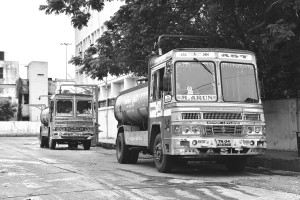Registered with the Registrar of Newspapers for India under R.N.I 53640/91
Vol. XXIX No. 1, April 16-30, 2019
Water recycling – the need of the hour
by The Editor
 Water tankers – a familiar sight in the City. (Photo: S. Raja Pandiyan.)
Water tankers – a familiar sight in the City. (Photo: S. Raja Pandiyan.)
And so the long-anticipated water crisis has come. The Chennai Water Supply and Sewerage Board (CMWSSB) is still sending the precious liquid via pipes but this may not be for long. Water tankers have reappeared, as have long queues of people waiting with plastic pots for their quota from these vehicles. With most of the city reservoirs touching rock bottom, the off take is now from abandoned quarries that have collected water.
The CMWSSB claims to be supplying 550 million litres every alternate day to the city, the actual demand being 850 million litres per day. Keeping up even with this level of supply may not be possible for long. Cynics have it that it will cease as soon as Chennai votes – on April 18th. The areas outside the purview of the CMWSSB’s piped water, and these include the entire IT corridor, are not much better off. They have relied on tankers supplying water extracted from the mofussil and with resources depleting there as well, the crisis can only deepen. Meteorological statistics have it that Chennai and its surroundings received 54 per cent less rain last year and we are now facing the consequences.
We earlier tackled such crises by the Telugu Ganga project, the Veeranam scheme, installing desalination plants (a high energy and therefore expensive solution) and rainwater harvesting. The last named was perhaps the first instance of Chennai showing some responsibility when it came to conserving water. Here again, reliable sources have it that the first wave of the scheme, initiated in 2001 by the then Chief Minister, was the only effective one and all measures adopted by buildings subsequently have been mere shams. Whatever be the truth in that, it cannot be denied that Chennai did make a success of conserving rainwater. But happens when it does not rain at all?
That is when we need to get going with the next step – recycling water, reducing its usage and more importantly, making sure wastage is brought down. Anyone would think that the CMWSSB would have by now come out with a notification on what can be done by private residents, hotels, hospitals and industrial establishments. There has been nothing so far. Huge imbalances in supply and consumption are the consequences. The economically deprived sections of the city are denied water. Supply is kept up to more affluent colonies. Those who can afford it resort to private purchase. There is no control over how this latter category spends the water it receives. Even though they are free to spend it the way they want to, they ought to know that they are depleting a precious resource and need to therefore restrict their consumption.
A couple of years ago it was announced by the CMWSSB that all new multi-storeyed and ‘special’ (whatever that means) buildings would need to recycle water. It is not clear if anyone is monitoring the implementation of this order or whether it has remained one of those diktats that just look good on paper. Chennai generates 500 million litres of sewage in a day (a figure not very different from the supply of water statistic quoted above). These are collected, treated, let out into waterways and eventually drain to the sea. Can it not be made mandatory for every building, even the older ones, to install facilities to recycle grey water? There are plenty of commercial solutions available and people need to begin considering them. Recycling of water also reduces wastage and more importantly, burdens the drainage system a lot less.
Will the present Government have the political will that it displayed in 2001 when it made rainwater harvesting compulsory and insist on recycling facilities being implemented within a timeframe?

